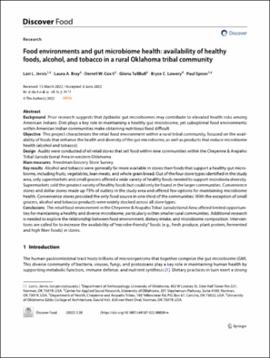| dc.contributor.author | Jervis, Lori L. | |
| dc.contributor.author | Bray, Laura A. | |
| dc.contributor.author | Cox, Darrell W. II | |
| dc.contributor.author | Tallbull, Gloria | |
| dc.contributor.author | Lowery, Bryce C. | |
| dc.contributor.author | Spicer, Paul | |
| dc.date.accessioned | 2022-08-24T17:28:16Z | |
| dc.date.available | 2022-08-24T17:28:16Z | |
| dc.date.issued | 2022-07-18 | |
| dc.identifier.citation | Jervis, L.L., Bray, L.A., Cox, D.W. et al. Food environments and gut microbiome health: availability of healthy foods, alcohol, and tobacco in a rural Oklahoma tribal community. Discov Food 2, 20 (2022). https://doi-org.ezproxy.lib.ou.edu/10.1007/s44187-022-00020-w | en_US |
| dc.identifier.uri | https://hdl.handle.net/11244/336498 | |
| dc.description.abstract | Background
Prior research suggests that dysbiotic gut microbiomes may contribute to elevated health risks among American Indians. Diet plays a key role in maintaining a healthy gut microbiome, yet suboptimal food environments within American Indian communities make obtaining nutritious food difficult. | en_US |
| dc.description.abstract | Objective
This project characterizes the retail food environment within a rural tribal community, focused on the availability of foods that enhance the health and diversity of the gut microbiome, as well as products that reduce microbiome health (alcohol and tobacco). | |
| dc.description.abstract | Design
Audits were conducted of all retail stores that sell food within nine communities within the Cheyenne & Arapaho Tribal Jurisdictional Area in western Oklahoma. | |
| dc.description.abstract | Main measures
Freedman Grocery Store Survey. | |
| dc.description.abstract | Key results
Alcohol and tobacco were generally far more available in stores than foods that support a healthy gut microbiome, including fruits, vegetables, lean meats, and whole grain bread. Out of the four store types identified in the study area, only supermarkets and small grocers offered a wide variety of healthy foods needed to support microbiota diversity. Supermarkets sold the greatest variety of healthy foods but could only be found in the larger communities. Convenience stores and dollar stores made up 75% of outlets in the study area and offered few options for maintaining microbiome health. Convenience stores provided the only food source in one-third of the communities. With the exception of small grocers, alcohol and tobacco products were widely stocked across all store types. | |
| dc.description.abstract | Conclusions
The retail food environment in the Cheyenne & Arapaho Tribal Jurisdictional Area offered limited opportunities for maintaining a healthy and diverse microbiome, particularly within smaller rural communities. Additional research is needed to explore the relationship between food environment, dietary intake, and microbiome composition. Interventions are called for to increase the availability of “microbe-friendly” foods (e.g., fresh produce, plant protein, fermented and high fiber foods) in stores. | |
| dc.language | en_US | en_US |
| dc.rights | Attribution 4.0 International | * |
| dc.rights.uri | https://creativecommons.org/licenses/by/4.0/ | * |
| dc.subject | Food environments | en_US |
| dc.subject | gut microbiome health | en_US |
| dc.subject | food | en_US |
| dc.subject | alcohol | en_US |
| dc.subject | tobacco | en_US |
| dc.subject | Oklahoma | en_US |
| dc.subject | health risks | en_US |
| dc.subject | American Indians | en_US |
| dc.title | Food environments and gut microbiome health: availability of healthy foods, alcohol, and tobacco in a rural Oklahoma tribal community | en_US |
| dc.type | Article | en_US |
| dc.description.peerreview | Yes | en_US |
| dc.identifier.doi | 10.1007/s44187-022-00020-w | en_US |
| ou.group | Dodge Family College of Arts and Sciences::Department of Anthropology | en_US |

